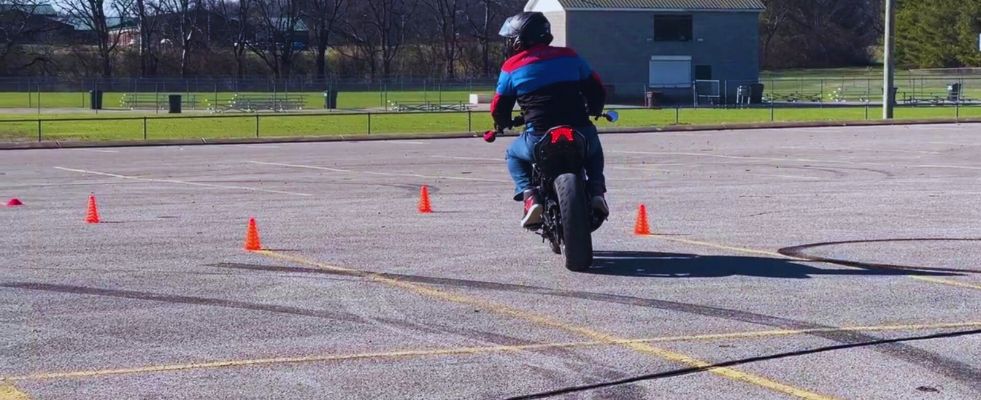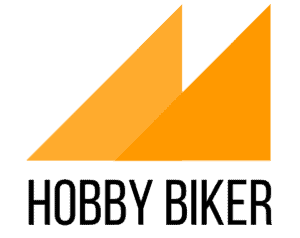I remember the first time I wrecked my bike.
I had it for all of one month and was already taking risks like riding on unfamiliar backroads, at night.
Needless to say, I came face to face with the Dunning-Krueger effect on a right-hand turn, flipping my bike off the side of the road and into a ditch.
Luckily my friends were there and we were able to ride the bike out and home.
And other than a jammed thumb and a few scrapes and scratches, the bike and I both made it out relatively unscathed.
But the ride home felt different. I was scared again. I was scared to ride.
After making it home and finally breaking the news to my wife, I assessed the bike, and other than a bent brake peg and some new scratches, she was perfectly rideable.
But in the following days, when my friends hit me up to ride again, I found myself making excuses.
Weeks passed and I had only taken the bike out once for a short ride before coming straight home.
It was like I was a new rider all over again – stiff as a board, on edge, and afraid to lean on right-hand turns.
My friends already knew what was up and reached out, offering the most counterintuitive but helpful advice to date.
Get back on the bike.
And they were right. The longer I waited to ride, the more the thought of riding scared me.
This guide is to help those who experiencing the same symptoms I did.
And with a little bit of faith, I can guarantee you will be back up to 100% in no time.
Get Back in the Saddle Early (Main Tip)

When it comes to overcoming fear after a motorcycle accident, the most counterintuitive yet effective advice is to get back on the bike as soon as you’re physically and mentally ready.
The longer you stay off the bike, the more your mind starts to amplify the fear, making it harder to return.
Here’s why and how to approach it:
Benefits of Returning Early
- Breaks the Fear Cycle: The longer you wait, the stronger your anxiety becomes. Early rides can disrupt this pattern.
- Rebuilds Muscle Memory: Riding helps you reestablish essential riding habits, making you feel more in control.
- Boosts Confidence Gradually: Each successful ride reinforces your ability, helping you replace fear with familiarity.
How to Get Your Confidence Back
Getting your confidence back is all about taking things slowly.
You can go through our Guide on How to Build Confidence on a Motorcycle, but here are a few tips:
- Start Small: Begin with short trips on familiar, low-traffic routes.
- Choose Calm Conditions: Ride during off-peak hours or in quiet neighborhoods to reduce pressure.
- Focus on Basics: Concentrate on smooth starts, stops, and turns to regain your rhythm.
- Set Personal Milestones: Celebrate small victories like your first solo ride or the first longer trip.
- Ride with Support: Invite a trusted riding buddy to join you for extra encouragement and safety.
Remember, progress is about consistency, not speed. Each ride is a step closer to feeling like yourself again on the road.
Evaluate, Learn, and Manage Your Fear

After an accident, it’s crucial to turn reflection into action.
Understanding what led to the incident can be a powerful tool for regaining confidence and preventing future mishaps.
Here’s how you can evaluate, learn, and manage the emotional triggers that come with getting back on the road:
Step 1: Analyze the Incident
- Ask the Tough Questions: What went wrong? Were there environmental factors, mechanical issues, or rider errors?
- Identify Avoidable Factors: Perhaps it was a sharp turn taken too fast or a lapse in attention. Pinpointing these helps prevent similar situations.
- Document Your Findings: Keeping a journal of your reflections can be therapeutic and insightful.
Step 2: Improve Your Skills
- Enroll in Advanced Riding Courses: Courses focused on defensive driving or advanced handling can boost both your skills and confidence.
- Practice Specific Scenarios: If a particular situation caused your accident, recreate it in a safe environment, such as a training course.
Step 3: Manage Emotional Triggers
- Gradual Exposure: Start by riding in low-pressure environments before tackling more challenging routes.
- Mindfulness Techniques: Breathing exercises, visualization, and progressive muscle relaxation can help you stay calm.
- Acknowledge Progress: Celebrate small wins to reinforce positive experiences and build resilience over time.
By combining self-assessment, skill improvement, and emotional management, you’ll create a strong foundation for safer and more confident riding.
Each step forward will ease your anxiety and strengthen your resolve.
Rebuild Confidence Through Practice

Confidence isn’t something that returns overnight—it’s rebuilt one ride at a time.
The key is to start small and gradually push your comfort zone in manageable steps.
Step 1: Begin with Familiar Routes
Starting on roads you know well can reduce anxiety. Familiar routes minimize surprises, allowing you to focus on getting comfortable with your bike again.
Step 2: Take Short, Simple Rides
Even a 10-minute ride around the neighborhood is a victory. These shorter trips help you re-establish control and reawaken muscle memory.
Step 3: Gradually Increase Duration and Complexity
Once short rides feel easy, extend them. Try longer routes or introduce mild challenges, like light traffic or slightly curvier roads.
- Intermediate Goals: Set specific milestones, such as a weekend ride to a nearby town.
- Challenge Yourself Gradually: Tackle more complex routes only when you feel ready—there’s no rush.
With each ride, your confidence will naturally grow.
The key is consistency—small, incremental steps will build a foundation of positive riding experiences and ease you back into feeling at home on the road.
Create a Strong Support Network

Rebuilding confidence after a motorcycle accident isn’t something you have to face alone.
A strong support network can make a huge difference in your recovery process, both emotionally and practically.
Ride with Experienced Friends
Riding with friends who are experienced and supportive can boost your confidence.
They can offer guidance, keep an eye on you, and help you feel safer on the road.
Plus, the shared experience often brings back the joy of riding.
- Buddy System: Ask a trusted friend to join you on short, easy rides until you feel more comfortable.
- Group Dynamics: Larger group rides can provide added confidence due to the collective presence on the road.
Join a Motorcycle Club or Online Community
Connecting with others who have been through similar experiences provides emotional support and valuable advice.
- Motorcycle Clubs: Local clubs often organize group rides that are ideal for easing back into riding. Riding in a group can provide a sense of security and shared purpose.
- Online Communities: Forums and social media groups can offer encouragement, tips, and a sense of belonging. Engaging in discussions with experienced riders can also help you learn from their stories.
A supportive network not only helps you overcome fear but also reminds you why you love riding in the first place.
The encouragement and camaraderie can be just the push you need to fully regain your confidence.
Long-Term Strategies for Safety and Confidence

Building confidence after a motorcycle accident is an ongoing process that doesn’t stop once you’re back on the road.
Adopting long-term strategies ensures you continue to ride safely and confidently.
Commit to Continuous Learning
The best riders are always learning.
Whether it’s enrolling in advanced riding courses or staying updated on road safety best practices, continuous learning sharpens your skills and reinforces safe riding habits.
- Advanced Riding Courses: Defensive riding and situational awareness training can make you a more proactive rider.
- Stay Informed: Follow motorcycle safety blogs, watch instructional videos, and stay updated on local traffic laws.
Routine Bike Maintenance
Confidence often comes from knowing your bike is in top shape.
Regular maintenance not only ensures your safety but also gives you peace of mind.
For a full breakdown, check out our Guide on the Essential Pre-ride Checklist.
- Pre-Ride Checks: Inspect tires, brakes, lights, and fluids before every ride.
- Scheduled Maintenance: Follow your bike’s maintenance schedule, and don’t hesitate to upgrade safety features like ABS or better tires.
Conclusion: Embrace the Journey

Getting back on your bike after an accident is a journey—one that requires resilience, patience, and a willingness to learn.
Every ride you take, every challenge you overcome, is a testament to your strength.
Remember why you started riding in the first place: the freedom, the thrill, and the community.

